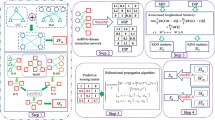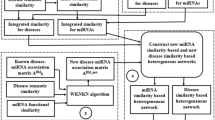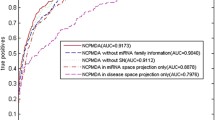Abstract
The prediction of association between disease and microRNAs is playing an increasing important role for understanding disease etiology and pathogenesis. So far, many various computational methods have been proposed by researchers to predict the potential associations between microRNAs and diseases. Considering that the past methods have many limitations, we developed Random Walking with Restart based Network Consistency Projection for Predicting miRNA-disease Association to uncover the relationship between diseases and miRNAs. Based on diverse similarity measures, the proposed model constructed the topological similarity of miRNAs and diseases by random walking with restart (RWR) algorithm on the similarity network, which took full advantage of the network topology information, and introduced the Gaussian interaction profile kernel similarity to get the integrated similarity of miRNA and disease, respectively. Then, we projected miRNA space and disease space on the miRNA-disease interaction network, respectively. Finally, we can obtain the predicted miRNA-disease association score matrix by combining the above two space projection scores. Simulation results showed that RWRNCP can efficiently infer miRNA-disease relationships with high accuracy, obtaining AUCs of 0.9479 and 0.9274 in leave-one-out cross validation (LOOCV) and five-fold cross validation (5CV), respectively. Furthermore, a case study also suggested that RWRNCP is promising for discover new miRNA-disease interactions.
Access this chapter
Tax calculation will be finalised at checkout
Purchases are for personal use only
Similar content being viewed by others
References
Ambros, V.: microRNAs: tiny regulators with great potential 107(7), 823–826 (2001)
Ambros, V.: The functions of animal microRNAs. Nature 431(7006), 350–355 (2004)
Ibrahim, R., Yousri, N.A., Ismail, M.A., Elmakky, N.M.: miRNA and gene expression basedcancer classification using self-learning and co-training approaches. In: IEEE International Conference on Bioinformatics and Biomedicine, pp. 495–498 (2014)
Katayama, Y., Maeda, M.: Identification of pathogenesis-related microRNAs in hepatocellular carcinoma by expression profiling. Oncol. Lett. 4(4), 817–832 (2012)
Meister, G., Tuschl, T.: Mechanisms of gene silencing by double-stranded RNA. Nature 431(7006), 343–349, 16–19 (2004)
Zheng, C.H., Huang, D.S.: Tumor clustering using nonnegative matrix factorization with gene selection. IEEE Trans. Inf Technol. Biomed. 13(4), 599–607 (2019)
Sethupathy, P., Collins, F.S.: MicroRNA target site polymorphisms and human disease. Trends Genet. 24(10), 489–497 (2008)
Li, J., et al.: Evidence for positive selection on a number of MicroRNA regulatory interactions during recent human evolution. Plos Genet. 8(3), e1002578–e1002590 (2012)
Chen, K., Rajewsky, N.: Natural selection on human microRNA binding sites inferred from SNP data. Nat. Genet. 38(12), 1452–1456 (2006)
Wang, D., Wang, J.: Inferring the human microRNA functional similarity and functional network based on microRNA-associated diseases. Bioinformatics 26(13), 1644–1650 (2010)
Chen, X., Xie, D.: MicroRNAs and complex diseases: from experimental results to computational models[J]. Brief. Bioinform. 20(2), 515–539 (2019)
Chen, X., Yan, C.C.: HGIMDA: Heterogeneous graph inference for miRNA-disease association prediction. Oncotarget 7(40), 65257–65269 (2016)
Chen, X., Yin, J.: MDHGI: matrix decomposition and heterogeneous graph inference for miRNA-disease association prediction. PLoS Comput. Biol. 14(8), e1006418–e1006442 (2018)
Chen, X., Zhu, C.C.: Ensemble of decision tree reveals potential miRNA-disease associations. PLoS Comput. Biol. 15(7), e1007209–e1007219 (2019)
Chen, X., Huang, L.: LRSSLMDA: laplacian regularized sparse subspace learning for MiRNA-disease association prediction. PLoS Comput. Biol. 20(2), 515–539 (2017)
Chen, X., Xie, D., Wang, L., Zhao, Q., You, Z.-H., Liu, H.: BNPMDA: bipartite network projection for MiRNA–disease association prediction. Bioinformatics 34(18), 3178–3186 (2018)
Chen, X., Wu, Q.F., Yan, G.Y.: RKNNMDA: ranking-based KNN for MiRNA-disease association prediction. RNA Biol. 14(7), 11–20 (2017)
Li, W., Cheng, Z.: Prediction of miRNA-disease association using deep collaborative filtering. Biomed. Res. Int. 2021, 1–16 (2021)
Li, H.Y., You, Z.H.: DF-MDA: an effective diffusion-based computational model for predicting miRNA-disease association from heterogeneous biological network. Mol. Ther. 26(13), 1644–1650 (2021)
Chen, X., Xing, Z., Zhou, Y.: ELLPMDA: ensemble learning and link prediction for miRNA-disease association prediction. Rna Biology 16, 363–372 (2018)
Goh, K.I., Cusick, M.E.: The human disease network. Proc. Natl. Acad. Sci. 104(21), 8685–8690 (2007)
Lu, M., Zhang, Q.: An analysis of human MicroRNA and disease associations. PLoS ONE 3(10), e3420–e3432 (2008)
Wang, D.: Inferring the human microRNA functional similarity and functional network based on microRNA-associated diseases. Bioinformatics 26, 1644–1650 (2010)
Lipscomb, C.E.: Medical subject headings (MeSH). Bull. Med. Libr. Assoc. 88, 265–266 (2000)
Chen, X., Wang, L.: Predicting miRNA-disease association based on inductive matrix completion. Bioinformatics 24, 4256–4265 (2018)
Jiang, Y., Liu, B., Yu, L.: Predict MiRNA-disease association with collaborative filtering. Neuroinformatics 16, 363–372 (2018)
Shao, B., Liu, B., Yan, C.: SACMDA: MiRNA-disease association prediction with short acyclic connections in heterogeneous graph. Neuroinformatics 20(2), 515–539 (2018)
Zhen, Y., Fei, R., Liu, C., et al.: dbDEMC: a database of differentially expressed miRNAs in human cancers. BMC Genomics 11(Suppl 4), 1–8 (2010)
Jiang, Q., Wang, Y., Hao, Y.: miR2Disease: a manually curated database for microRNA deregulation in human disease. Nucleic Acids Res. 37(Database), D98–D104 (2009)
Acknowledgement
This work was supported by the National Natural Science Foundation of China (Nos. 61873001, U19A2064, 61872220, 11701318), Natural Science Foundation of Shandong Province (grant number ZR2020KC022), and the Open Project of Anhui Provincial Key Laboratory of Multimodal Cognitive Computation, Anhui University, No. MMC202006.
Author information
Authors and Affiliations
Editor information
Editors and Affiliations
Rights and permissions
Copyright information
© 2021 Springer Nature Switzerland AG
About this paper
Cite this paper
Zhang, MW., Wang, YT., Gao, Z., Li, L., Ni, JC., Zheng, CH. (2021). RWRNCP: Random Walking with Restart Based Network Consistency Projection for Predicting miRNA-Disease Association. In: Huang, DS., Jo, KH., Li, J., Gribova, V., Premaratne, P. (eds) Intelligent Computing Theories and Application. ICIC 2021. Lecture Notes in Computer Science(), vol 12838. Springer, Cham. https://doi.org/10.1007/978-3-030-84532-2_47
Download citation
DOI: https://doi.org/10.1007/978-3-030-84532-2_47
Published:
Publisher Name: Springer, Cham
Print ISBN: 978-3-030-84531-5
Online ISBN: 978-3-030-84532-2
eBook Packages: Computer ScienceComputer Science (R0)




